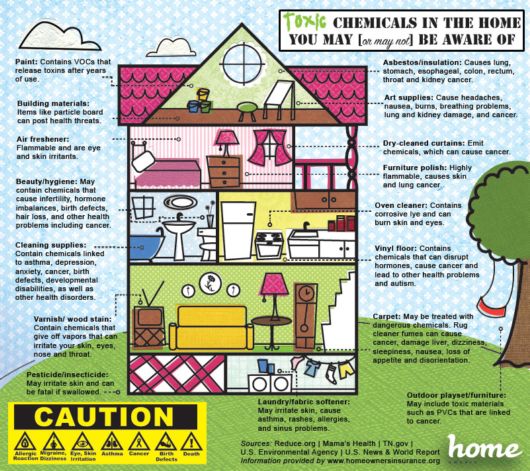
Hidden toxins in your home can cause you and your family serious health problems. Here?s a list of the worst offenders and how to protect yourself from toxins in your home.
Laundry Room: Dryer Sheets
Dryer sheets were my entree into the land of toxin-free living when I learned that the substance used to soften clothes is often derived from animal fats. (YUCK!) But the fragrances used in dryer sheets can be even worse, containing chemicals like benzyl acetate, benzyl alcohol and terpines?all toxic, and some carcinogenic. Switch to DIY dryer balls instead and use essential oils for that fresh laundry smell.
Bathroom: Bleach-based Cleaners and Wipes
Because of years of branding, bleach can seem like the only choice when it comes to disinfecting germy surfaces in the bathroom and kitchen, but the health risks of the toxic chemicals in bleach can outweigh the benefits. Chemicals in bleach are highly corrosive to the skin and lungs, and the chemical chlorine in bleach is used in the chemical weapon mustard gas. If bleach is mixed with ammonia (which is found in urine, by the way) it creates a deadly gas. And when mixed with wastewater, it?s known to form numerous carcinogenic compounds. Switch to white vinegar, baking soda, or even boiling water for your disinfecting needs.
Kitchen: Oven Cleaner
Oven cleaners sold in the store are chock full of toxins, including lye (also known as ?caustic soda?), ethers, ethylene glycol, methylene chloride and petroleum distillates. They even release butane (a neurotoxin) when you spray them. Switch to a simple paste made from baking soda and water, and then line the bottom of your oven with aluminum foil to make future clean ups easier.
Living Room: Carpets
Carpets are the No. 2 cause of air pollution in the home?right after cigarette smoke?because they?re treated with all kinds of toxic chemicals, from flame retardants to stain repellents. Bare wood or tile floors are best, but swapping traditional carpets for natural-fiber carpets can make a big difference.
Dining Room: Scented Candles
Believe it or not, those romantic candlelit dinners could be hazardous to your health. Lots of commercial candles contain tiny metal wires in the wicks that can release lead into the air. In addition, most of the fragrances contain plasticizers and other solvents that shouldn?t be inhaled. Even plain beeswax and soy candles release hydrocarbons into the air when burned, which can cause respiratory problems. Experts suggest limiting candle burning to special occasions.
Kids? Room: Art Supplies
Coloring and drawing seem like such harmless kid activities, but it depends on the tools. Dry erase markers top the list for toxicity because they usually contain the solvent xylene, a neurotoxin. Colored pencils can contain lead (look for lead-free varieties) and even water-based markers can contain alcohols that can be toxic.
Nursery: Baby Wipes
One of the most ubiquitous baby tools, conventional baby wipes, can be toxic. Many contain bronopol, an antimicrobial compound that?s toxic to the skin, immune system and lungs. Many also contain pthalates, which are known endocrine disruptors. Look for natural brands that don?t contain these harsh chemicals?or just use soap and water.
Bedrooms: Furniture
Most of us start out with inexpensive particle-board furniture when we are setting up house, but particle board or pressed wood usually contains formaldehyde or isocyanate glues, which give off toxic fumes?sometimes for years. Upholstered furniture made with polyurithane foam can also contain brominated and chlorinated flame retardants, which also offgas toxic vapors. Your best choice? Solid wood furniture, even if it?s second hand.
Porch or Deck: Pressure-Treated Wood
Pressure treated wood has preservatives forced into it under high pressure that help repel insects and prevent rot. But the chemicals used, like alkaline copper quat and copper azole, can be very toxic. When building a new porch or deck, look for wood that?s been treated with the less-toxic borate preservatives.
Yard: Fertilizers and Pesticides
It?s a status symbol in suburbia to have a lush, green, golf-course-like lawn, but all those chemical pesticides, weed killers and fertilizers can be very harmful?especially to pets and kids, who, let?s face it, are the ones most likely to be rolling around in the grass in the first place. Switch to organic lawn treatments, but be aware that even organic treatments can sometimes be harmful to pets and kids in high doses. Read labels carefully.

